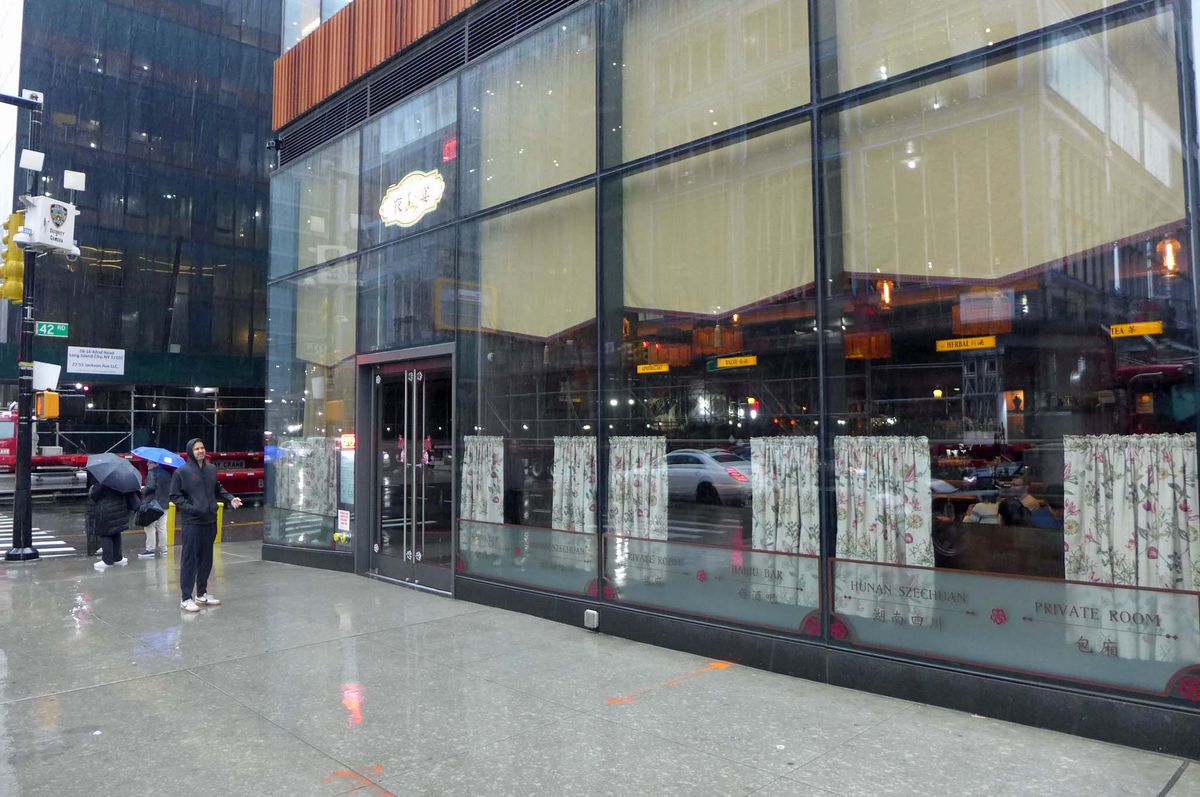Welcome to the Scene Report, a column in which Eater captures the vibe of a notable New York restaurant at a specific moment in time. Read other scene reports here, here, and here.
Over the last decade, a building boom in Long Island City has left the easternmost blocks of Jackson Avenue jammed with gleaming office towers and apartment buildings, ending at Queens Plaza’s E, M, and R station. These five blocks have become one of the city’s newest and glitziest dining strips, with all sorts of franchise operations, but also with a preponderance of independent Chinese and Japanese establishments, some quite large.

The latest restaurant to appear along the strip, on the first floor of the the Tishman Speyer’s Jacx office tower, Red Sorghum (28-03 Jackson Avenue, at 42nd Road) has opened, related to Ye’s Apothecary, a Chinatown cocktail bar, and Blue Willow, a Midtown Hunan restaurant. It is run by Vincent Lin and Blue Willow partner, Mandy Zhang, and the executive chef is Bruce Li. The Chinese name, “Night Banquet,” references the 1987 film and Chinese novel about a family’s struggles in making sorghum wine and later resistance fighters during the Second Sino-Japanese War; in an interview, the owners said the setting is inspired by “old-school cinema and Wong Kar Wai’s set designs.”
The vibe: Like Blue Willow, Red Sorghum might be mistaken for a movie set from the 1930s. The predominant color is red, the subdued lighting seems to issue mainly from beaded lampshades and Edison bulbs that hang from the high ceiling. Fringed decorative blinds can be pulled down over the giant windows to give an impression of evening, even in mid-afternoon. A bar dominates the room from right inside the front door.
Orange banquettes weave around the place, interspersed with bent cane chairs, leaving semi-hidden nooks here and there. Large Chinese vases dot the room, some filled with flowers, others with potted plants. Mid-afternoon on a Saturday, the place was mobbed. This is not a restaurant for wearing t-shirts and sweatpants, and the patrons dress up a bit, even on a weekend. Most tables hold several guests, the better to take advantage of the large format dishes.


The food: Red Sorghum concentrates on Sichuan and Hunan, two popular regional Chinese cuisines, both quite spicy. The menu is filled with familiar dishes including one with eggplant, green chiles, and century eggs ($20) mashed tableside in a mortar; and a fiery fish soup that features green peppercorns, here made not with tilapia, but with the more luxurious black sea bass.
Illustrating the Hunanese penchant for preserved ingredients, there is a stir-fry of dried radish and smoked pork ($22). There are also homestyle selections on the menu, such as a creamy soup of red dates and pork meatballs ($21), and a dish disarmingly called Miss Lou’s famous beef stew ($34), a homely concoction of sliced brisket, enoki mushrooms, and (transparent Japanese) konjac noodles.


The drinks: Red Sorghum doubles as a cocktail lounge, and a very scene-y one, too. Many drinks feature baijiu, a clear, high-proof liquor often made with sorghum, but sometimes with wheat, corn, millet, or a combination. It is consumed all over China, often as straight shots, but at Red Sorghum, one may have a sorghum sling ($17), composed of hawthorn berry, mint, and pineapple with baijiu, and so on. There’s also a Negroni that features two forms of baijiu along with mezcal and vermouth; and a warm cocktail of Pimm’s and Pastis flavored with vanilla and allspice.
True to the name of the restaurant, there are 18 kinds of straight baijiu offered in six flavor categories (strong, extra strong, rice, light, sauce, and phoenix). These are available in flights of four ($20), if you really want to find out what baijiu is all about. Then there are red, white, sparkling, and skin-contact wines, as well as an international selection of whiskeys, and pretty much every form of booze you can think of, plus zero-alcohol spirits — but no one’s going to blame you if you just stick with beer.

Tips: Bring a crowd to order a more diverse range of dishes, and dress up a bit so you won’t feel like a schlump.
